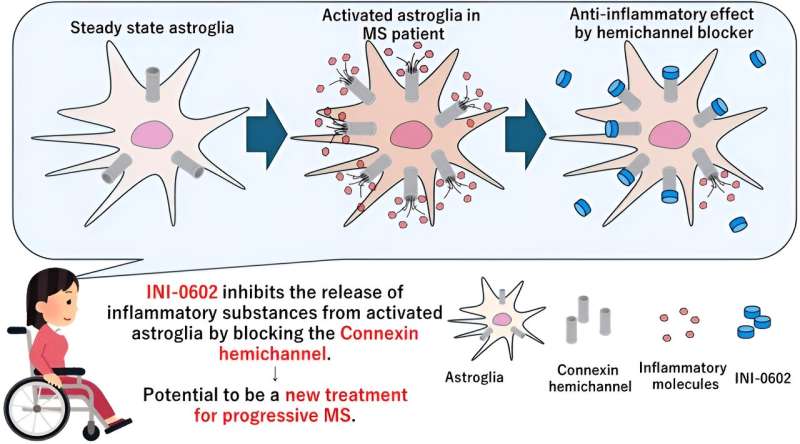This article has been reviewed according to Science X's editorial process and policies. Editors have highlighted the following attributes while ensuring the content's credibility:
fact-checked
peer-reviewed publication
trusted source
proofread
A new therapeutic target offers a promising pathway for multiple sclerosis treatment

Researchers from Kyushu University have identified a potential therapeutic target for the treatment of advanced multiple sclerosis (MS), a potentially disabling condition associated with the central nervous system.
In their study, conducted using an experimental mouse model of MS, they explored the role of connexin 43 (Cx43), a protein involved in cellular communication and cardiac function, and examined whether targeting this protein with specific blockers could improve MS symptoms.
Like most neurodegenerative diseases, MS has very limited treatment options, more so once it reaches the chronic stage. To add to this, MS affects nearly three million people worldwide, making it a massively challenging neurological disease.
Though our understanding of the precise nature of MS is limited, researchers have established that MS is caused by the patient's own immune system wreaking havoc on their central nervous system. Specifically, the immune system attacks the protective myelin sheath surrounding nerve fibers in the brain and spinal cord, causing demyelination and creating areas of scarring and damage called lesions.
In a 2013 study, researchers from Kyushu University, including Associate Professor Ryo Yamasaki from the Faculty of Medical Sciences, found that the production of Cx43 was increased in supportive cells called astroglia, near chronic MS lesions.
Cx43 is essential for cell-to-cell signaling and plays a key role in modulating the immune system. The researchers therefore hypothesized that Cx43 could play a pivotal role in promoting neuroinflammation—a process where the immune response is triggered to fight off infection or heal damaged tissue—in the context of MS, ultimately leading to demyelination.
The study published in Scientific Reports on May 13, 2024, by Yamasaki, in collaboration with researchers from the International University of Health and Welfare, adds further support to the hypothesis that Cx43 plays a key role in causing MS.
The study revealed that a drug called INI-0602, which effectively 'plugs' and blocks Cx43 channels, markedly improved MS symptoms in experimental mice.
The researchers conducted an extensive series of experiments in an experimental mouse model of MS and in cultured astroglia cells from the mouse model, to understand the effects of Cx43 blockade.
The results of these tests and analyses were quite consistent, suggesting that INI-0602 could not only suppress the overproduction of Cx43 in astroglia, but also mitigate many of the hallmark features of MS, including demyelination and excessive immune cell infiltration into the nervous system.
By delving further into the mechanisms underlying these results, the team found that INI-0602 led to improved symptoms by regulating immune processes. More specifically, treatment with this compound reduced the levels of pro-inflammatory cytokines—proteins produced by immune cells that trigger the immune system—and increased those of anti-inflammatory cytokines in the cerebrospinal fluid.
The drug also altered calcium signaling in astroglia, limiting their ability to promote inflammation. Together, these effects reduced disease severity in the mouse model.
Overall, the findings of this study have important implications for future MS therapies. "Targeting Cx43 channels with specific blockers like INI-0602 could serve as a novel therapeutic strategy for chronic MS. This, in turn, could facilitate the development of new treatments for patients with MS," says Yamasaki.
He adds, "Our findings also challenge a critical issue in MS treatment, that of limiting disease progression in chronic stages by targeting Cx43, where current treatments are found to be less effective."
Yamasaki also notes that a similar strategy could be applied to other neurodegenerative diseases where astroglia activation and channels like Cx43 are disease modifying factors, such as amyotrophic lateral sclerosis.
However, animal models do have some limitations, and whether the same techniques or drugs can be used in humans is something that remains to be thoroughly tested.
The research team is already planning to work on this in the near future. As Yamasaki explains, "We plan to conduct clinical trials in the future to evaluate the safety and efficacy of INI-0602 in human patients with MS. Additionally, we also plan to look at the molecular mechanisms of Cx43 in influencing neuroinflammation and demyelination in detail."
More information: Ezgi Ozdemir Takase et al, Astroglial connexin 43 is a novel therapeutic target for chronic multiple sclerosis model, Scientific Reports (2024). DOI: 10.1038/s41598-024-61508-2



















